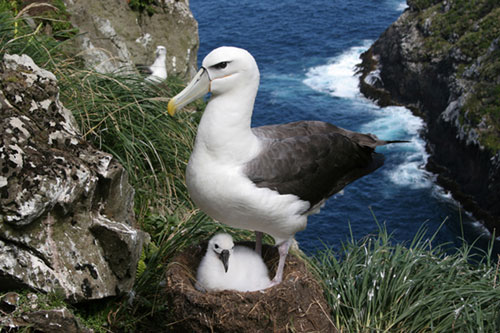Leigh Torres of the National Institute of Water and Atmospheric Research (NIWA) in New Zealand and colleagues have studied the degree of overlap between individual albatrosses and fishing vessels using GPS trackers, publishing their findings last month in the journal Marine Ecology Progress Series.
The paper's abstract follows:
"Incidental bycatch of seabirds in commercial fishing activities is known to cause declines in seabird populations. However, the full impacts on the ecology of seabirds, including effects on seabird distribution and behavior, through the association with fisheries are not fully understood. We developed a novel method to integrate fine-scale GPS tracking data from the foraging trips of 25 white-capped albatross Thalassarche steadi within sub-Antarctic New Zealand with fishing effort distribution data to (1) quantify fine-scale overlap between individual albatrosses and individual vessels and (2) characterize behavioral changes in albatrosses when they are associated with fishing vessels. Overlap between vessels and albatrosses occurred in 68% of tracks. However, albatrosses demonstrated high variability in foraging trip destinations and association rates with fishing activity, both between and within individuals. Eight tracks never overlapped a fishing vessel. Of the 17 tracks that did overlap, a range of 2 to 73% of foraging effort on each trip occurred while overlapping a fishing vessel. Albatross foraging behavior was characterized by a significantly slower and straighter path when overlapping vessels. This study highlights the utility of GPS tags to examine the fine-scale distribution of seabirds in relation to fishing activity, revealing how effects of fisheries on marine megafauna may extend beyond mortality and injury as well as population numbers. However, results are currently constrained, not only by limited tracking data sets, but also by the quality (spatio-temporal resolution) and availability of fishing effort data. Critical conservation issues related to the effects of fisheries on threatened marine megafauna cannot be fully addressed without comparative data sets with resolution equal to GPS tags."
Reference:
Torres, L.G., Thompson, D.R., Bearhop, S., Votier, S., Taylor, G.A., Sagar, P.M. & Robertson, B.C. 2011. White-capped albatrosses alter fine-scale foraging behavior patterns when associated with fishing vessels. Marine Ecology Progress Series 428: 289-301.

For the use of a similar technique see also:
Votier, S.C., Bearhop, S., Witt, M.J., Inger, R., Thompson, D.R. & Newton, J. 2010. Individual responses of seabirds to commercial fisheries revealed using GPS tracking, stable isotopes and vessel monitoring systems. Journal of Applied Ecology 47: 487-497.
John Cooper, ACAP Information Officer, 14 June 2011

 Français
Français  English
English  Español
Español